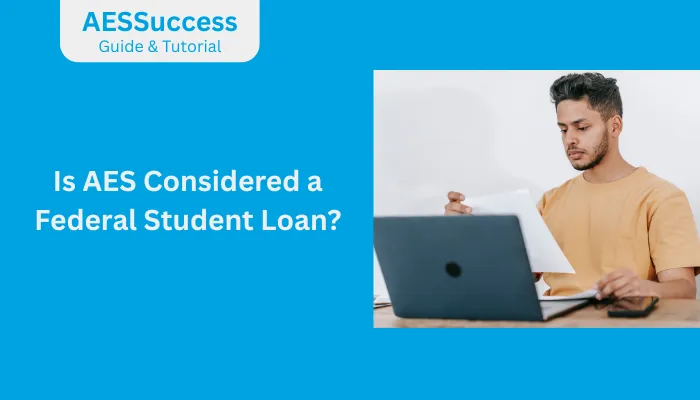As someone who’s navigated the maze of student loans, I know how confusing it can be to figure out who’s managing your debt and what kind of loan you have. Is AES considered a federal student loan? That’s a question I’ve tackled before, and I’m here to guide you through it with clarity.
If you’re getting bills from AESsuccess, you might wonder if your loan is federal or private. Let’s dive into my experience and break it down step-by-step to help you understand your loans and make informed decisions about repayment.

Understanding AES and Its Role
I’ve dealt with American Education Services (AES) for years, and it’s critical to grasp what they do. AES is a student loan servicer, not a lender, meaning they manage loans but don’t issue them.
They handle billing, payments, and customer service for millions of borrowers. Let’s clear up the confusion about their role.
What Is AES?
When I first got a letter from AES, I assumed they were my lender. Nope! AES, part of the Pennsylvania Higher Education Assistance Agency (PHEAA), services loans under the Federal Family Education Loan Program (FFELP) and private loans. They’re like the middleman, ensuring your payments reach the lender and answering your questions.
- AES was established in 1963 by PHEAA to service FFELP loans.
- They manage over 4.48 million borrowers with $155.7 billion in student debt.
- They also service private loans, often for National Collegiate Student Loan Trusts.
I learned AES doesn’t set interest rates or loan terms—those come from the lender or Congress for federal loans. Knowing this helped me focus on my repayment options.
Why the Confusion About AES Loans?
I asked this when I saw AES on my credit report. The mix-up happens because AES services both federal and private student loans. If your loan is part of the FFELP, it’s federal; if it’s with a private lender like National Collegiate Trust, it’s not.
I’ve found that understanding your loan’s origin clears the fog. Let’s move to identifying whether your AES loan is federal. This section laid the groundwork, and now I’ll show you how to confirm your loan type.
How to Identify Your AES Loan Type?
I’ve been in your shoes, staring at loan statements, wondering, “Is AES considered a federal student loan?” To get answers, I checked specific resources. Here’s how you can do it too.
Checking the National Student Loan Data System (NSLDS)
The first thing I did was log into the National Student Loan Data System (NSLDS) at studentaid.gov. This database lists all federal student loans. If your AES loan appears here, it’s federal, likely an FFELP loan like a Stafford or PLUS loan.
- Visit studentaid.gov and sign in with your FSA ID.
- Navigate to the “My Aid” section to see your loan details.
- Look for AES under “Loan Servicer” to confirm it’s federal.
If your loan isn’t in NSLDS, it’s likely private. I double-checked my credit report to confirm.
Reviewing Your Credit Report
When I didn’t see my loan in NSLDS, I pulled my credit report from AnnualCreditReport.com. Private loans serviced by AES, like those from National Collegiate Trust, show up here. This step confirmed my loan wasn’t federal.
- Request a free credit report from Equifax, Experian, or TransUnion.
- Look for AES or the lender’s name under your accounts.
- Note the loan type—private loans won’t mention FFELP.
Wondering, “Is AES considered a federal student loan?” If it’s in NSLDS, yes; if only on your credit report, probably not.
Contacting AES Directly
I called AES at 1-800-233-0557 to get clarity. Their reps can tell you the loan’s origin. I also logged into AESsuccess.org to check my account details, which sometimes list the lender.
This process helped me pin down my loan type, and now I’ll explain the differences between federal and private loans. Identifying your loan type is empowering, and next, I’ll break down why it matters.
Federal vs. Private Loans: Why It Matters
Knowing whether AES is considered a federal student loan impacts your repayment options. I’ve managed both types, and the differences are huge. Let’s compare them.
Federal Student Loan Benefits
When I discovered my AES loan was an FFELP loan, I unlocked federal benefits. These loans, though discontinued in 2010, offer protections private loans don’t.
| Feature | Federal (FFELP) Loans | Private Loans |
|---|---|---|
| Repayment Plans | Income-driven, graduated, extended plans | Limited, lender-specific plans |
| Forgiveness Programs | Possible via consolidation (e.g., PSLF) | Rarely available |
| Interest Rates | Fixed, set by Congress | Variable or fixed, set by lender |
| Deferment/Forbearance | Available for hardship, school, military | Limited, depends on lender |
- Income-Driven Repayment (IDR): I enrolled in an IDR plan, capping payments at 10-15% of my income.
- Loan Forgiveness: FFELP loans can qualify for Public Service Loan Forgiveness (PSLF) if consolidated into a Direct Loan.
- Deferment: I paused payments during unemployment without interest piling up on subsidized loans.
Private Loan Limitations
My private AES loan was trickier. Private loans lack federal protections, and I had fewer options.
- No IDR plans or forgiveness programs unless the lender offers them.
- Refinancing is the main way to lower rates, but I lost federal benefits when I refinanced.
- Hardship options are lender-specific—I had to negotiate with National Collegiate Trust.
That’s a common question, especially if you’re juggling multiple loans. If AES is managing your account, it might still be a federal student loan, but not always—so double-check your loan type to avoid surprises.
Understanding these differences shaped my repayment strategy, and now I’ll share how to manage AES loans. The loan type guides your next steps, so let’s explore repayment options with AES.
Managing Your AES Student Loans
I’ve tackled student loan repayment with AES, and understand AES is considered a federal student loan? is key—because that answer shapes how you manage repayment, forgiveness options, and more.
Federal Loan Repayment Options
For my FFELP loans, AES offered flexible plans. I explored these to ease my monthly burden.
- Standard Repayment: Fixed payments over 10 years.
- Graduated Repayment: Starts low, increases every two years.
- Income-Based Repayment (IBR): Payments based on income and family size.
- Deferment/Forbearance: I paused payments during financial hardship.
I set up autopay on AESsuccess.org for a 0.25% interest rate reduction. Contact AES at 1-800-233-0557 to explore these.
Private Loan Repayment Options
My private loan had fewer options, but I worked with AES to manage it.
- Contact the lender through AES to negotiate terms.
- Consider refinancing for a lower rate, but shop around.
- Check for hardship programs—some lenders offer temporary relief.
Tips for Success
- Log into AESsuccess.org regularly to track payments.
- Use the AES mobile app for on-the-go management.
- Keep records of all communications with AES to avoid disputes.
The Question is, is AES considered a federal student loan? Understanding the answer can help you choose the right repayment or forgiveness plan. These strategies kept me on track, and now I’ll wrap up with final thoughts.
Conclusion
Navigating student loans can feel overwhelming, but I’ve been there, and I’m confident you can master it too. Is AES considered a federal student loan? That depends—if your loan was issued under the FFEL Program, then yes. Otherwise, it might be private, so be sure to check the NSLDS or your credit report to know for sure
By understanding your loan type and leveraging AES’s tools, you can take control of your repayment. Visit AESsuccess.org or call 1-800-233-0557 to start managing your loans today. Stay proactive, and you’ll find a path to financial freedom with confidence and clarity.
